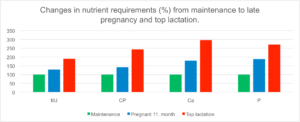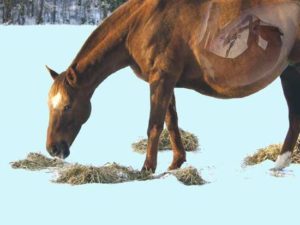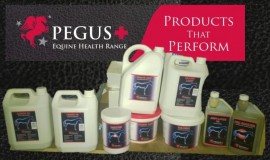Adjusting rations for the mares in late pregnancy
At this time of year, many pregnant mares are in their last months of pregnancy. The foetus now increases its growth rate and demands more nutrients to support that growth. The mare has to deliver these nutrients to her foetus and her ration will have to be adjusted accordingly
Foetal growth
In the first 7 months of pregnancy, the foetus grows moderately and only reaches about 20% of its final birth weight. This means that the mare’s nutrient requirements in this period changes little compared to maintenance requirements. However, during the last 3-4 months of pregnancy, foetal growth accelerates. During the very last month before foaling, the foetus gains about 30% of it’s final birth weight. The body weight of a normal new-born foal is approximately 10% of the mare’s normal body weight, which means that a foal is relatively large at bir
Nutrient requirements for pregnancy
All the nutrients needed to produce a foal (muscles, skeleton, hooves, hair etc) have to be delivered to the foetus from the mare’s blood stream. Understandably, this represents a considerable challenge. To avoid depletion of the mare’s own body reserves, we have to offer a ration that covers the increased nutrient demands of the foetus. The body of a new-born foal is composed to a large extent of protein (muscle), minerals (skeleton) and water. In the last month of pregnancy, relative to maintenance, the mare’s requirements are increased 30% for energy, 75% for protein and 80% to 85% for calcium and phosphorous.

Quality control
Normally, rations for pregnant mares are composed of more than 2/3rds roughage. This means that knowing the nutrient content of your roughage is of major importance. Having your horse’s roughage analysed for at least energy (MJ), crude protein, calcium and phosphorous should be seen as part of quality controlling your horse breeding. Roughages vary a lot, particularly in relation to protein and calcium content, and it is not possible to estimate the content of these nutrients by visual inspection alone. We need roughage that is well analysed, and to use those analysed values when composing the rations.
Once roughage has been analysed, Pegus Horse Feed can be of great help. The analysed values can be entered into the Pegus PC-Horse feed list and used directly when composing rations.
Condition at foaling
It is vital that the mare is in good condition at foaling. This will not only affect milk production after foaling, but also fertility. Mares are normally covered during the “foal heat”, about 9-11 days after foaling, or in the next heat occurring about 30 days after foaling. To optimize the chances for a new pregnancy, the mare should be in good condition and well-balanced nutritionally.
For further help in arranging your feed plan for your mare , contact Pegus directly for free advice and diet planning.
Free Phone Helpline R.O.I.= 1800-378463 UK = 0800 011 4182















